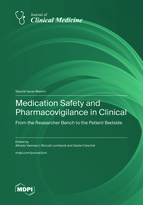Medication Safety and Pharmacovigilance in Clinical: From the Researcher Bench to the Patient Bedside
A special issue of Journal of Clinical Medicine (ISSN 2077-0383). This special issue belongs to the section "Pharmacology".
Deadline for manuscript submissions: closed (30 April 2023) | Viewed by 28118
Special Issue Editors
Interests: pharmacovigilance; pharmacology; toxicology; pharmacoepidemiology; drug safety; clinical pharmacy; medical pharmacology
Special Issues, Collections and Topics in MDPI journals
2. Tuscan Regional Centre of Pharmacovigilance, 50122 Florence, Italy
Interests: clinical pharmacology and toxicology; pharmacovigilance and pharmacoepidemiology
Special Issues, Collections and Topics in MDPI journals
2. Tuscan Regional Centre of Pharmacovigilance, 50122 Florence, Italy
Interests: clinical pharmacology and toxicology; pharmacovigilance and pharmacoepidemiology
Special Issues, Collections and Topics in MDPI journals
Special Issue Information
Dear Colleagues,
Recent years, particularly the COVID-19 pandemic, can be considered as a turning point for pharmacovigilance and pharmacoepidemiology in terms of their role in drug safety and drug utilization monitoring in clinical practice. In this context, researchers operating in the fields of pharmacovigilance and pharmacoepidemiology have extensive knowledge about approved medications, many of which have been or are currently undergoing clinical trials for repurposing. Among them, clinical pharmacologists’ knowledge can be used and translated to optimize dosing and treatment regimens and to assess the relationship between drug exposure and adverse drug events, with the crucial aims of optimizing drugs’ efficacy and ensuring drug safety in a real-world setting.
Real-world data are crucial to further establish the safety profile of pharmacological treatments. As a next step, real-world data from electronic health databases may be used in pharmacovigilance and pharmacoepidemiology to monitor drug utilization patterns, as well as the efficacy and safety of drugs in large populations. Furthermore, this approach will be particularly useful in the near future for the monitoring of COVID-19 vaccines’ efficacy and safety.
In the present Special Issue, experts are invited to submit population-based studies (cohort or case–control studies), drug utilization studies, systematic reviews and meta-analyses, and review articles that contribute to improving the understanding of the role of pharmacovigilance and pharmacoepidemiology, before, during and after the COVID-19 pandemic.
We would be honored to have robust contributions from experts in order to update the scientific literature on this important and complex topic.
Prof. Dr. Alfredo Vannacci
Dr. Niccolò Lombardi
Dr. Giada Crescioli
Guest Editors
Manuscript Submission Information
Manuscripts should be submitted online at www.mdpi.com by registering and logging in to this website. Once you are registered, click here to go to the submission form. Manuscripts can be submitted until the deadline. All submissions that pass pre-check are peer-reviewed. Accepted papers will be published continuously in the journal (as soon as accepted) and will be listed together on the special issue website. Research articles, review articles as well as short communications are invited. For planned papers, a title and short abstract (about 100 words) can be sent to the Editorial Office for announcement on this website.
Submitted manuscripts should not have been published previously, nor be under consideration for publication elsewhere (except conference proceedings papers). All manuscripts are thoroughly refereed through a single-blind peer-review process. A guide for authors and other relevant information for submission of manuscripts is available on the Instructions for Authors page. Journal of Clinical Medicine is an international peer-reviewed open access semimonthly journal published by MDPI.
Please visit the Instructions for Authors page before submitting a manuscript. The Article Processing Charge (APC) for publication in this open access journal is 2600 CHF (Swiss Francs). Submitted papers should be well formatted and use good English. Authors may use MDPI's English editing service prior to publication or during author revisions.
Keywords
- pharmacovigilance
- drug safety
- pharmacoepidemiology
- observational study
- clinical pharmacology
- toxicology
- clinical practice
- real-world data









